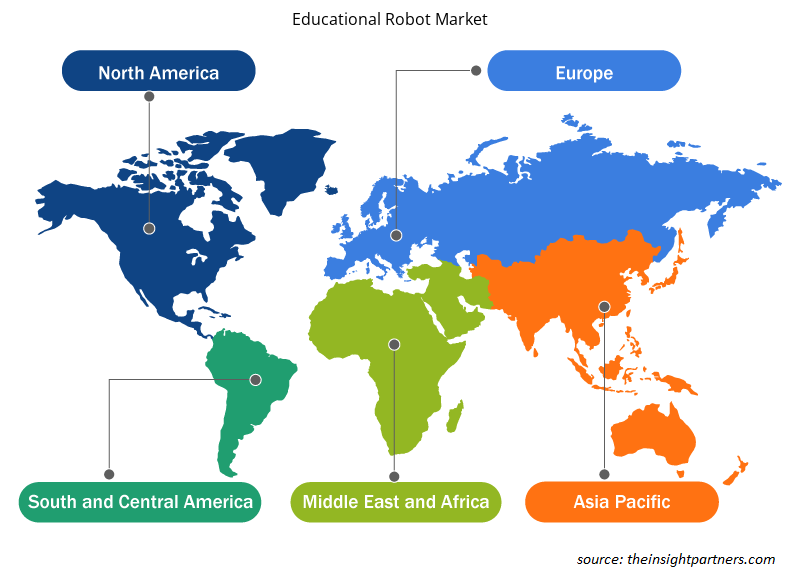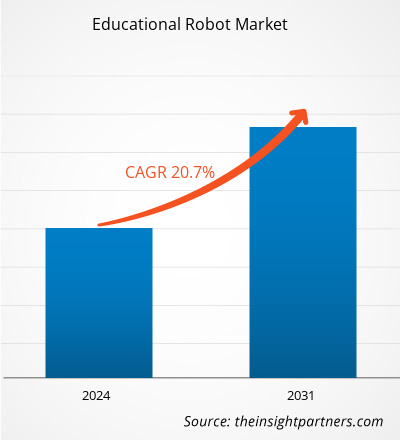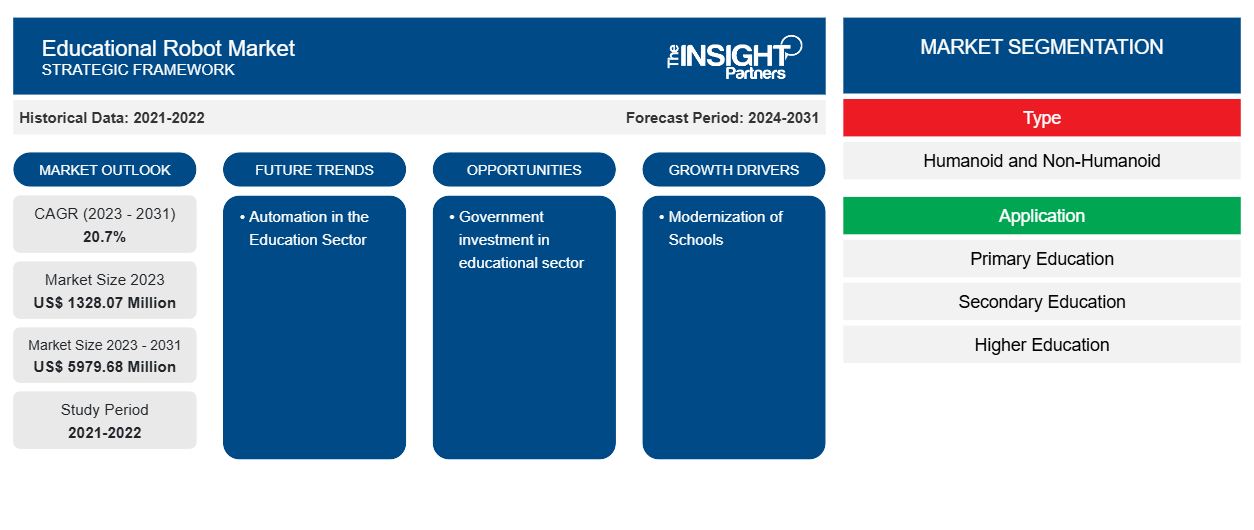预计到 2031 年,教育机器人市场规模将从 2023 年的 13.2807 亿美元增至 59.7968 亿美元。预计 2023-2031 年期间,该市场的复合年增长率将达到 20.7%。政府对教育领域机器人和自动化的投资可能仍是市场的主要趋势。
教育机器人市场分析
对加强科学、技术、工程和数学 (STEM) 的关注日益增加,推动了市场增长。政府当局对教育系统的投资进一步促进了市场增长。学校和学院正在包括机器人技术的各个方面,从而推动了市场增长。
教育机器人市场概况
教育机器人是可编程机器人,可帮助各个年龄段的学生加深对机器人技术和编程的了解。此外,它还帮助他们学习其他认知技能。它为学生提供构建和编程可执行各种任务的机器人所需的一切。
定制此报告以满足您的需求
您可以免费定制任何报告,包括本报告的部分内容、国家级分析、Excel 数据包,以及为初创企业和大学提供优惠和折扣
-
获取此报告的关键市场趋势。这个免费样品将包括数据分析,从市场趋势到估计和预测。
教育机器人市场驱动因素和机遇
学校现代化
政府正在大力投资教育领域,以实现学校和学院的现代化,并进一步提高学生的学习能力。这些投资鼓励市场参与者向学校提供教育机器人,从而推动市场增长。例如,2022 年 4 月,丹麦的 Shape Robotics 表示已与当地同行 KUBO Robots 签署协议,向罗马尼亚的学校分发教育机器人。
教育领域的自动化
ABB 于 2023 年对 2,301 名教育专业人士进行的全球调查发现,80% 的人认为机器人和自动化将在未来十年内塑造就业的未来。机器人在教育系统和教学计划中的使用。工业机器人市场参与者专注于在教育领域推出机器人,这将推动未来教育机器人市场的发展。
教育机器人市场报告细分分析
有助于得出教育机器人市场分析的关键部分是类型和应用。
- 根据类型,教育机器人市场分为人形机器人和非人形机器人。非人形机器人在 2023 年占据了最大的市场份额。
- 根据应用,市场分为小学教育、中学教育、高等教育和其他。其他部分在 2023 年占据了相当大的市场份额。
教育机器人市场份额按地区分析
教育机器人市场报告的地理范围主要分为五个区域:北美、亚太、欧洲、中东和非洲、南美和中美。
预计亚太地区在预测期内的复合年增长率最高。该地区专注于教育领域的技术进步。教育领域不断增加的投资补充了市场增长。机器人在学校的引入进一步推动了该地区市场的增长。例如,2024 年 3 月,喀拉拉邦的一所学校引进了该国第一位 AI 教师 Iris,向教育迈出了创新的一步。Iris 是与 Makerlabs Edutech 合作创建的,是该州乃至全国第一位人形机器人教师。Iris 能够回答各个科目的复杂问题,提供个性化的语音支持,并促进互动式教育机会。此外,Iris 还配备了轮子以增加移动性。
教育机器人市场区域洞察
Insight Partners 的分析师详细解释了预测期内影响教育机器人市场的区域趋势和因素。本节还讨论了北美、欧洲、亚太地区、中东和非洲以及南美和中美洲的教育机器人市场细分和地理位置。

- 获取教育机器人市场的区域特定数据
教育机器人市场报告范围
| 报告属性 | 细节 |
|---|---|
| 2023 年的市场规模 | 13.2807亿美元 |
| 2031 年市场规模 | 59.7968亿美元 |
| 全球复合年增长率(2023 - 2031) | 20.7% |
| 史料 | 2021-2022 |
| 预测期 | 2024-2031 |
| 涵盖的领域 |
按类型
|
| 覆盖地区和国家 |
北美
|
| 市场领导者和主要公司简介 |
|
教育机器人市场参与者密度:了解其对业务动态的影响
教育机器人市场正在快速增长,这得益于终端用户需求的不断增长,这些需求源于消费者偏好的不断变化、技术进步以及对产品优势的认识不断提高等因素。随着需求的增加,企业正在扩大其产品范围,进行创新以满足消费者的需求,并利用新兴趋势,从而进一步推动市场增长。
市场参与者密度是指在特定市场或行业内运营的企业或公司的分布情况。它表明在给定市场空间中,相对于其规模或总市场价值,有多少竞争对手(市场参与者)存在。
在教育机器人市场运营的主要公司有:
- 艾索机器人
- 汉森机器人有限公司
- 模块化机器人
- PAL机器人
- 发那科美国公司
- 三宝创新科技有限公司
免责声明:上面列出的公司没有按照任何特定顺序排列。

- 了解教育机器人市场顶级关键参与者概况
教育机器人市场新闻和最新发展
教育机器人市场通过收集一手和二手研究后的定性和定量数据进行评估,其中包括重要的公司出版物、协会数据和数据库。以下列出了教育机器人市场的一些发展情况:
- ABB 机器人公司推出 IRB 1090,扩大了其教育产品范围。1090 工业教育机器人经全球公认教育机构 STEM.org 认证,旨在提高学生的技能,为他们提供就业竞争优势。这款新型教育机器人是 ABB 更广泛的教育产品的重要组成部分,其中包括其他工业机器人、教育套件、下一代控制器以及市场领先的编程和仿真软件。(来源:ABB 机器人公司,新闻稿,2023 年 9 月)
- MatataStudio 是一家以创新和原创为核心的数字学习解决方案提供商,推出了一款名为“VinciBot”的新型教育机器人套件,旨在将计算机科学、人工智能和教育以娱乐的方式结合起来。将人工智能 (AI) 和机器学习 (ML) 等高科技概念引入小学课堂。这些机器人套件不仅具有很高的教育意义,还融合了编程、计算思维、创造力和探索。MatataStudio 的设计理念是鼓励孩子们通过亲手建造和操作机器人来掌握编程和计算机科学的基础知识,同时培养他们的创新思维和解决问题的能力。(来源:MatataStudio,新闻稿,2024 年 2 月)
教育机器人市场报告覆盖范围和交付成果
“教育机器人市场规模和预测(2021-2031)”报告对以下领域进行了详细的市场分析:
- 范围内涵盖的所有主要细分市场的全球、区域和国家层面的教育机器人市场规模和预测
- 教育机器人市场趋势,以及驱动因素、限制因素和关键机遇等市场动态
- 详细的 PEST/波特五力分析和 SWOT 分析
- 教育机器人市场分析涵盖主要市场趋势、全球和区域框架、主要参与者、法规和最新市场发展
- 行业格局和竞争分析,涵盖市场集中度、热点图分析、知名参与者以及教育机器人市场的最新发展
- 详细的公司简介
- 历史分析(2 年)、基准年、预测(7 年)及复合年增长率
- PEST和SWOT分析
- 市场规模、价值/数量 - 全球、区域、国家
- 行业和竞争格局
- Excel 数据集
近期报告
相关报告
客户评价
购买理由
- 明智的决策
- 了解市场动态
- 竞争分析
- 客户洞察
- 市场预测
- 风险规避
- 战略规划
- 投资论证
- 识别新兴市场
- 优化营销策略
- 提升运营效率
- 顺应监管趋势























 获取免费样品 - 教育机器人市场
获取免费样品 - 教育机器人市场